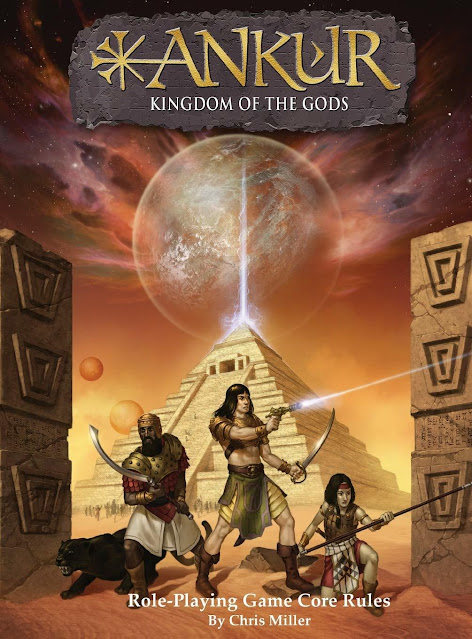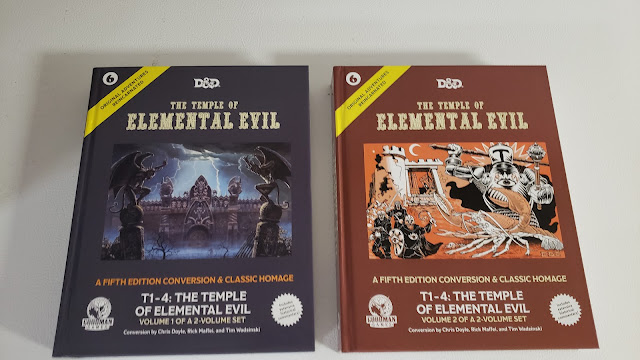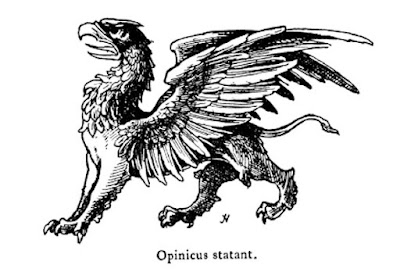This is the start of a multi-part sub-feature of One Man's God. I am going to pull in material from older Dragon Magazines when needed, though not enough to count as a "This Old Dragon." This series will also allow me to pull in more up-to-date material for the various gods and creatures beyond what was in the Deities and Demigods. The D&DG will be my starting point, but I am not limited to it now.
Since I have completed all the myths in the Deities and Demigods the initial goal of One Man's God is now complete. I might, after this, look to other editions of (A)D&D, in particular, 2nd and 3rd but for now, I want to explore some other topics that came up in my OMG posts.
One of those topics is syncretism.
Syncretism is the combining of gods or beliefs into a new set of gods and/or belief systems. This is something that happens in the real world all the time, though maybe less so now as the prevalence of monotheism is worldwide. We do see it more modern times in the cases of religions like Vodun and Santería.
While you typically don't see syncretism in AD&D there is at least one excellent example of it. Going all the way back to Dragon #54 from October 1981, we have Ed Greenwood's Down-to-Earth Divinity.
I am not sure if this article lead to the later developments of what the Cleric can do with their gods or not, but it was most certainly ahead of it's time. A quick reminder, while Greenwood has been telling us about his campaign for a bit now, the Forgotten Realms, as a product, was not due till 1987.
I covered this in an early This Old Dragon, here is what I said about it then:
Up first in real articles we have something from Ed Greenwood. So this year (2017) I have been spending some time expanding my knowledge of the Forgotten Realms. This article is one of the earliest articles on the Realms I know of. Down-to-earth Divinity discusses how Ed has put together his Pantheon of Gods. You can easily see how this evolved into the gods of the Realms. I found it interesting that he includes the elemental gods from the Melnibonéan mythos. There are a lot of "reskinned" Deities and Demigods gods here too (which is the point of the article). I liked that Ed specifically mentions that witches worship Selûne. The article is long and seriously good.
I feel I undersold how good this article is for my purposes. So not only can use this as a One Man's God entry in the pure sense it is also the perfect place to discuss syncretism. The insight to how the Realms gods took shape is fascinating, the implications of what is going here are much more interesting.
For the sake of today's discussion, let us just focus on the Faerûnian Pantheon as a whole. While they have evolved much since this article (and a further point in my case here). For modern examples, I will refer to the Faerûnian pantheon at the Forgotten Realms wiki.
Faerûnian Gods
In this article, Greenwood details how he created the Gods of Faerûn. Many of these gods are "reskinned" versions of Earth gods. While there is a very practical game-design reason for this there is also an implied in-universe explanation; clerics of those gods came to Toril and brought their gods with them. We see this in books, like Neil Gaiman's "American Gods" and we see it later in the Realms itself with the Mulhorandi pantheon, which are the Egyptian Gods, not even changed all that much.
For his Gods, Greenwood choose to stick pretty close to the first printing of the Deities and Demigods. Again there are very practical reasons for this. Here is a breakdown of the "immigrant" gods to Faerûn.
This is not to imply that all Gods in Faerûn are imports. Far from it! Many of the gods discussed in the article are different enough from their sources to be considered new gods. Which is exactly what syncretism does. There are also plenty of brand new gods. For example, Mystra is nothing at all like Hecate.
What About Demons and Other Gods?
One Man's God is supposed to be about gods and demons right? Certainly, the demons of the Monster Manual ARE the demons of Faerûn. We know that Orcus has had a lot plots and schemes in the Realms since the very start. And in the opposite direction, One Man's Demon is another's God, Asmodeus went from the Arch Duke of the devils to a God of Evil. The details of his rise and fall have been dealt with in many books, but the best ones for my money come from the Brimstone Angels series by Erin Evans.
Evans also shows how imported gods can work. The Pantheon of the Untheric Gods, which were the Babylonian Gods, were re-adopted by the Abeir Dragonborn living in Tymanther. In her book "The Devil You Know" Evans shows Untheric/Babylonian gods first as human-like then as Dragonborn-like as more of the Dragonborn living in Djerad Thymar came to believe in them, in particular the God Enlil. Is it possible then that Bane IS Druaga, just evolved through the ages that his form has changed? Isn't that also syncretism?
Nothing Like the Sun...
I have been going over this article for a very long time. There is quite a lot here to tease out and use if you are willing to take the time. A good example of this comes from a tiny tidbit of information found in the paragraph for Selûne, then just Selune. We are told that Selune is "revered by witches (and a few may worship her)." Later on, in the Deity/Character Relationships table, we are told that the witches used are the ones from Dragon Magazine #43.
Reading through the various works on the Moon Goddesses, Selûne and Shar, and the Elven Sehanine Moonbow, there is a lot of back and forth on who is an aspect of who and what not. This all lead me to a bit of syncretism of my own to combine all three goddesses into one Goddess of the Moon with three aspects. I detailed this years ago in my "Chanel Divinity" article Nothing Like the Sun. Each goddess represents the aspects of the triple Goddess; Maiden, Mother, and Crone or Sehanine, Selûne and Shar respectively. Here they are more than just the Goddesses of the Moon but the Goddess of Witchcraft as well. The waxing crescent is Sehanine and her "moonbow." The full moon is the Mother Selûne in her full glory. The waning crescent is Shar and her sickles to reap the souls of the dead. But like their Goddess they are reborn as the Maiden once more.

Realms diehards might ask how can these Goddess exist? Well, I also ask why does Zeus-Serapis exist when, supposedly, Zeus, Serapis, and Osiris also still exist? I like my Gods and Goddesses to be mysterious and strange and maybe a little contradictory.
For a little under 9 pages of text, Ed Greenwood really delivered here. So much so that in truth this blog post was started months back. I wanted to go back and reread posts I had made about this, posts I had made influenced by this, and more Forgotten Realms information. In truth, I could go on much longer about this topic just in the Realms themselves, the world is much more dynamic that I had given it credit for, but I am going to stay on topic here and move on to other worlds and other gods.
So. Thank You, Ed Greenwood. This is quite a quality bit of work.
One Man's God Special: Syncretism














